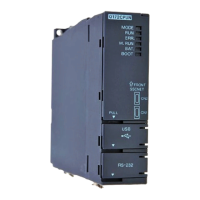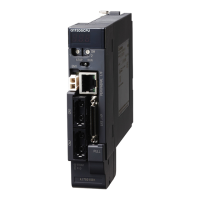5 - 72
5 OPERATION CONTROL PROGRAMS
F/FS G
5.12 Motion-Dedicated Functions
5.12.1 Speed change request : CHGV
Format CHGV((S1), (S2)) Number of basic steps 4
[Usable data]
Setting
data
Usable Data
Bit device
Word device Constant
Calculation
expression
Bit
conditional
expression
Comparison
conditional
expression
16-bit
integer
type
32-bit
integer
type (L)
64-bit
floating
point
type (F)
Coasting
timer
16-bit
integer
type (K/H)
32-bit
integer type
(K/H, L)
64-bit
floating
point
type (K)
(S1) — — — — —
— — — — —
(S2) —
— —
—
— —
: Usable
[Setting data]
Setting data Description Data type of result
(S1)
Axis No. to which speed change request will be
given
—
(S2) Specified speed
[Functions]
(1) A speed change is made shown below.
(a) The speed change accepting flag (M2061 to M2092) corresponding to the
axis specified with (S1) is turned ON.
(b) The speed of the axis specified with (S1) is changed to the speed specified
with (S2).
(c) The speed change accepting flag is turned OFF.
(2) The axis No. that may be set at (S1) is within the following range.
Q173DSCPU Q173DCPU(-S1) Q172DSCPU Q172DCPU(-S1)
1 to 32 1 to 16 1 to 8
(3) For interpolation control, set any one of the interpolation axes to (S1). When linear
interpolation control is exercised, a speed change varies as described below with
the positioning speed designation method set in the servo program.
Positioning speed designation method
Operation
Vector speed designation
Speed change is made so that the vector speed
becomes the speed specified with (S2).
Longest axis designation
Speed change is made so that the longest axis speed
becomes the speed specified with (S2).
Reference axis speed designation
Speed change is made so that the reference axis
speed becomes the speed specified with (S2).

